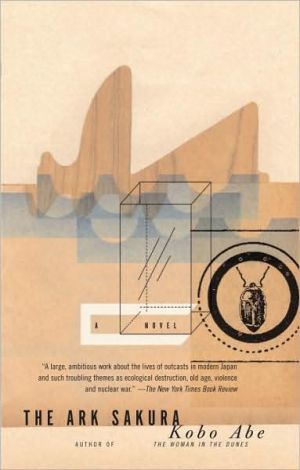

 |

|

The average rating for The Ark Sakura based on 2 reviews is 3 stars.
Review # 1 was written on 2010-04-10 00:00:00 Bonnie Cervantes Bonnie CervantesDuring my impoverished student years, I used to work at a local grocery store to meet ends. It was about two blocks away from my house. Everyday, my walks to work included terrifying encounters with a raggedy woman brimming with delusional paranoia of the world ending amid armageddon showers; her constant yelling was eerie and scared the daylights out of me. Enter the world of 'Mole'- a middle-aged, stout man who stays true to his nickname; dwelling in an abandon stone-quarry in an obscure landscape away from civilization. He is a poster child for misanthropy and delusional paranoia. A self-confessed "Noah", presumes to build an ark to save mankind from future nuclear holocaust. Unlike Noah, I deem that his celestial prophecies were strictly induced from large amount of caffeine that he guzzled along with cheap beers. So, with the mirage of being "the savior", he goes on a monthly excursion to the malls to recruit the choicest specimens (people) who he finds worth giving a ticket to his futuristic ship. During one of his outings he assembles a trio- an insect seller, and a couple of shills. The group ultimately lands in the stone quarry and an onset of surreal and macabre atmosphere reveals the incongruous circumstances. The rest of the manuscript discusses an array of topics from old age in the form of the Broom Brigade, environmentalism, survival, murder, allegiance, sex, humanity and nuclear devastation. The vocabulary commences strongly with personalized characterization of every actor, revealing idiosyncrasies with gritty metaphors making the individuals authentic thriving in their recluse milieu. The insect seller-Komono, who trades these paper-like fictitious insects-'eupcaccia', find affinity towards Mole; identifying these insects to be a placard of his own misanthropic lifestyle. Lacking friends or family, Mole compares himself to the eupcaccia, a fictional self-contained bug that feeds on its own feces. The concept of alienation shines with every passage giving a deep sense of the hermit life-styles and an acquired misanthropic quality with the fear of being ridiculed. Abe's bringing into play of creatures to be a metaphor to human life can be seen in his other book 'Woman in Dunes' correlating the mechanism of creepy-crawly manners to human philosophy. "Take the anthropoids, which are thought to share a common ancestor with the human race. They exhibit two distinct tendencies: one is to make groups and build societies'the aggrandizing tendency'and the other are for each animal to huddle in its own territory and build its own castle 'the settling tendency. For whatever reason, both these contradictory impulses survive in the human psyche. On the one hand, humans have acquired the ability to spread across the earth, thanks to an adaptability superior even to that of rats and cockroaches; on the other, they have acquired a demonic capability for intense mutual hatred and destruction." Kobo Abe a proficient in surrealism and absurdity lacks lucidity in this particular manuscript. The assembly of classic outcasts and uncanny personality is quiet attention-grabbing with little quirks spilling from every character's movements through the coherent narration. However, with introduction of new characters and embellishments of senseless jargon, the tale turns into this muddled cauldron of jumbling and irksome recitation. Through endless yawns and blank stares, I eventually drifted building my own castle in the sky with flying ponies. |
Review # 2 was written on 2011-03-28 00:00:00 Kenneth Buchanan Kenneth BuchananI now know where Murakami got his groove. And Abe got his from Kafka. There is an important scene early on in The Ark Sakura. Mole is at a swap meet, or the Japanese equivalence, and he spots a dealer selling strange insects. The eupcaccia, or clockbug, is an insect that has no feet. It revolves to face the sun and is therefore useful as a form of clock. It spins around but goes nowhere. Mole becomes fond of this insect and sees it as an analogy to his own life. It's a clever analogy and holds promise for the rest of the novel. In the first half Mole meets the other protagonists of this tale and things go along well. But as we get to Mole's so called Ark, his plan to survive the coming nuclear holocaust, the novel take a downward turn. Absurdism quickly degenerates into silliness. In other words, his Kafka becomes Ionesco. This strange and interesting tale just goes off into too many corners and one too many monologues. In one bizarre segment it literally goes down the toilet. I enjoyed the strangeness of Abe's writings but this is nowhere near the brilliance of his Woman in the Dunes. To borrow from a popular food book series; Don't read this, read that. |
CAN'T FIND WHAT YOU'RE LOOKING FOR? CLICK HERE!!!